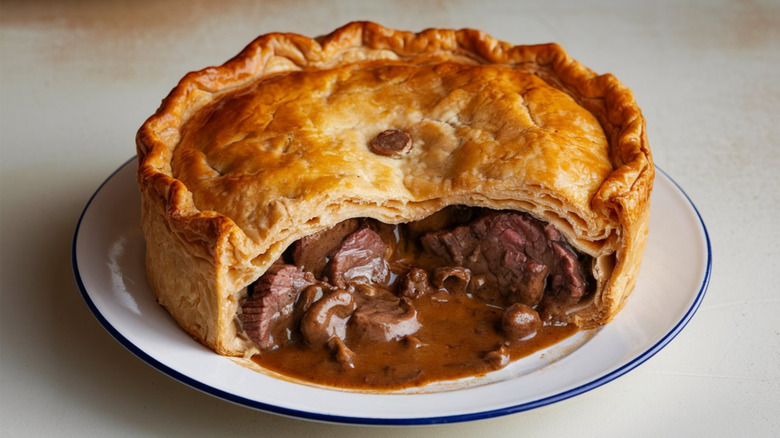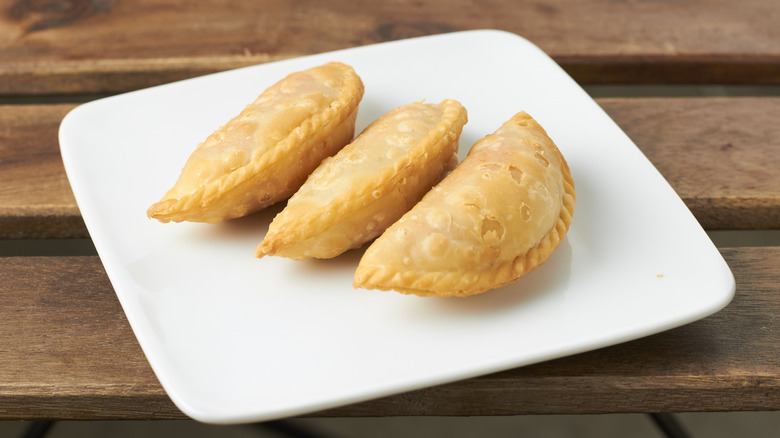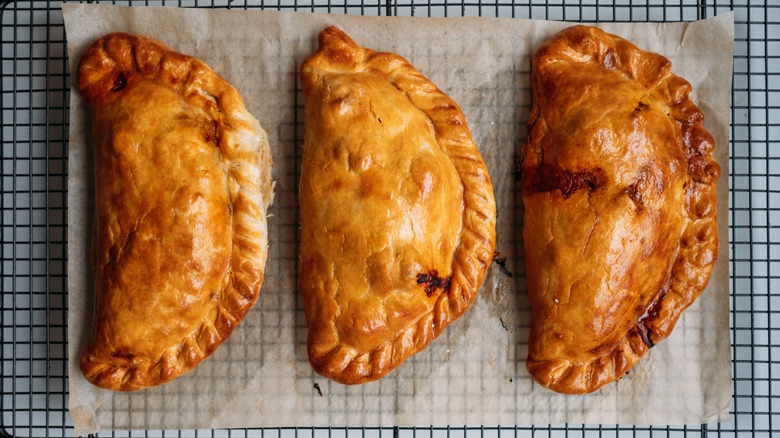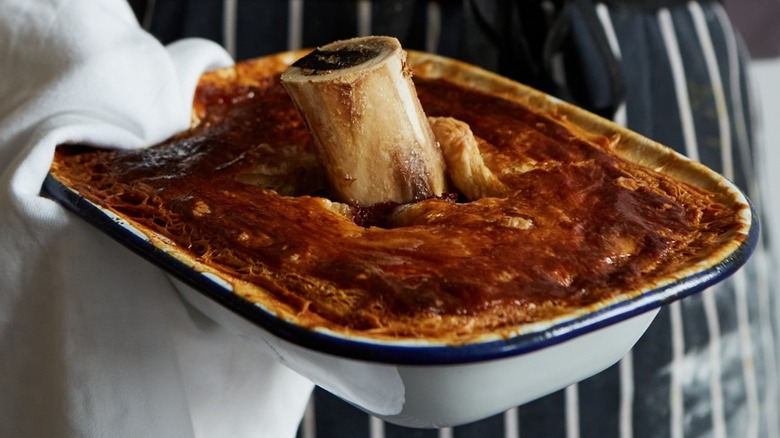Which Pastry Is Best For Steak Pie?
The steak pie is one of those wonderfully persistent dishes that seems to crop up just about everywhere. It's one of the dishes you must eat if you only have 24 hours in London. Although often associated with British cookery (indeed, the Brits love their pies and are very good at making and eating them) the unimpeachable combination of beef and pastry can be found not just all over Europe, but all over the world. Originating — so the story goes — in medieval England more as a method of preservation than a dish in and of itself — with the pie crust acting as a sort of "ye olde Tupperware" — the steak pie is a deceptively simple thing, invariably delicious, and importantly, easy to make at home. Now, the filling will likely get most of the attention — but it's only really half the dish. The pastry you use for your steak pie will make or break it, and can turn a good pie into a great one: But which is the best?
The traditional choice for a steak pie is actually a combination of two different types: A shortcrust pastry for the base, and crispy puff pastry for the top. It's the most commonly found choice for a reason — hearty shortcrust provides structural integrity without compromising on flavor, standing up to the test of a rich, meaty, gravy-soaked filling. The puff pastry, meanwhile, provides both a buttery finish to what is an undeniably bold flavor profile, and a beautifully crunchy, flaky texture that contrasts with the soft filling, and the crumbly shortcrust pastry beneath.
What about using puff pastry all over?
Of course, the combination of a shortcrust base and a puff pastry top is far from the only way to construct a fantastic steak pie. However, it's a solid choice if you'd like to achieve that classic, self-contained pie shape, like you might find with an Australian pie or in a traditional London pie-and-mash shop. But if you're a fan of the crunchy-on-the-outside, soft-on-the-inside texture of a great puff pastry, you could experiment with using it for your entire pie crust. The hand pie is not exactly niche, after all, and thrives when made exclusively with puff pastry.
This is a more common practice in Asia, particularly in Singapore and Malaysia, where the so-called curry puff has become the stuff of street food legend. This portable parcel of spicy, curried deliciousness is made with a puff pastry dough, which is filled, and then baked or fried. Though not usually made with the steak filling that Western palates might be more accustomed to, there's no reason why the technique couldn't be re-tooled to make for a fantastic, ultra-flaky, handheld steak pie– plus, you'll be able to keep your other hand free for the perfect beer pairing for a steak pie. Of course, you could also forgo the base altogether and make a pot pie, topped with puff pastry. A simple, yet delicious option, made all the easier with the addition of store-bought pastry (if this store-bought ingredient is good enough for Prue Leith, it's good enough for you).
Forgo the puff pastry, and use only shortcrust
If you're keen on the idea of just using one type of pastry, but don't fancy puff pastry, shortcrust is the way to go. Unlike with puff, there's no shortage of brilliant, traditional steak pie variations that use shortcrust pastry, and once again the hand pie frequently crops up. Take, for example, the famous Cornish pasty. Originating (unsurprisingly) in the 1300s in Cornwall, in the south of England, the pasty was designed to be a portable, hearty lunch for tin miners. Though traditionally made with both sweet and savory fillings in the same pie (the sweet end being marked with a small initial to let the hungry miner know which end he should start from) today the most popular filling is steak.
The shortcrust pastry makes for a perfect accompaniment to such a hearty filling, providing a wonderful balance of subtle, savory flakiness and chewy crunch — as well as having enough structural integrity to hold such heavy fillings. For home cooks, the pastry is much more achievable and far less time-consuming than making puff pastry — though if you're in a pinch (or just feeling a little bit lazy) the store-bought stuff will almost certainly turn out just as good.
For the best of both worlds, use suet pastry
On an unassuming street in Smithfield, a small pocket of east London that's home to the city's most celebrated meat market, there's an equally unassuming building with a name painted in simple black lettering above the door. The building is an old smokehouse, which since 1994 has been home to a restaurant called St. John. In the 30 years since its founding, it's quietly become known as one of the world's most influential restaurants (if you've seen bone marrow on a menu, chances are it's because this place did it first). And if there's one thing the restaurant's chef-patron Fergus Henderson loves, it's a pie.
In a city with a grand pie-making tradition, St. John's calculated approach lies in the pastry. Rather than the more commonly used puff or shortcrust pastries, Henderson goes down a different route entirely: suet pastry. If you don't know what suet is, it's a crucial ingredient in many traditional British dishes, using fat that has been rendered from around a cow's kidneys. Prized among bakers, the pie crust requires only suet, self-raising flour, and salt, and yields an utterly delicious and extremely forgiving dough. It provides all the best qualities of puff and shortcrust pastry, yet with an additional dumpling-like texture within, perfect for soaking up all that gravy. Plus, it's dead simple to make — for a steak pie, it can't be beat.



